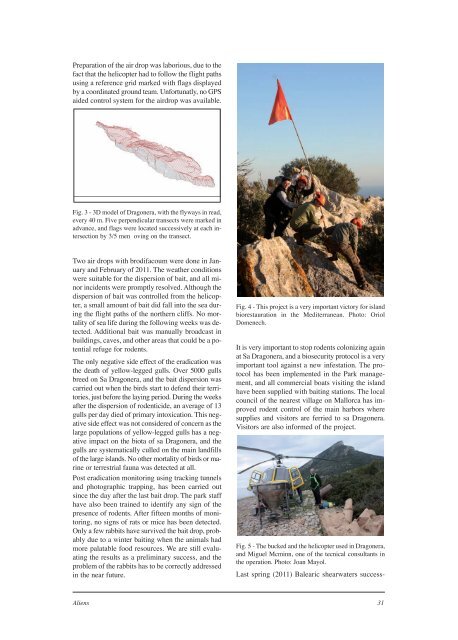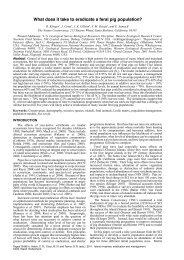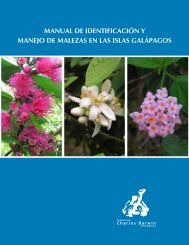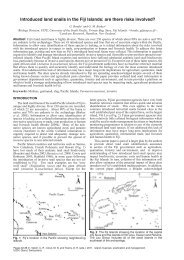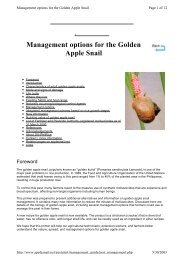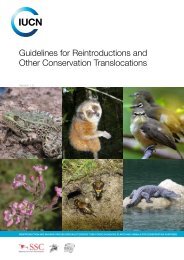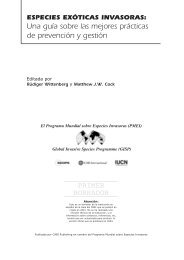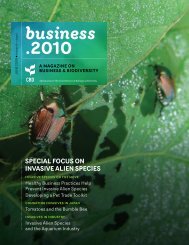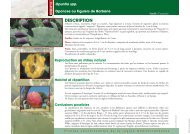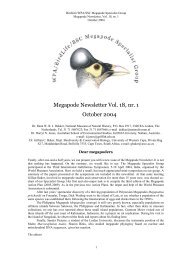Aliens - ISSG
Aliens - ISSG
Aliens - ISSG
You also want an ePaper? Increase the reach of your titles
YUMPU automatically turns print PDFs into web optimized ePapers that Google loves.
Preparation of the air drop was laborious, due to the<br />
fact that the helicopter had to follow the flight paths<br />
using a reference grid marked with flags displayed<br />
by a coordinated ground team. Unfortunatly, no GPS<br />
aided control system for the airdrop was available.<br />
Fig. 3 - 3D model of Dragonera, with the flyways in read,<br />
every 40 m. Five perpendicular transects were marked in<br />
advance, and flags were located successively at each intersection<br />
by 3/5 men oving on the transect.<br />
Two air drops with brodifacoum were done in January<br />
and February of 2011. The weather conditions<br />
were suitable for the dispersion of bait, and all minor<br />
incidents were promptly resolved. Although the<br />
dispersion of bait was controlled from the helicopter,<br />
a small amount of bait did fall into the sea during<br />
the flight paths of the northern cliffs. No mortality<br />
of sea life during the following weeks was detected.<br />
Additional bait was manually broadcast in<br />
buildings, caves, and other areas that could be a potential<br />
refuge for rodents.<br />
The only negative side effect of the eradication was<br />
the death of yellow-legged gulls. Over 5000 gulls<br />
breed on Sa Dragonera, and the bait dispersion was<br />
carried out when the birds start to defend their territories,<br />
just before the laying period. During the weeks<br />
after the dispersion of rodenticide, an average of 13<br />
gulls per day died of primary intoxication. This negative<br />
side effect was not considered of concern as the<br />
large populations of yellow-legged gulls has a negative<br />
impact on the biota of sa Dragonera, and the<br />
gulls are systematically culled on the main landfills<br />
of the large islands. No other mortality of birds or marine<br />
or terrestrial fauna was detected at all.<br />
Post eradication monitoring using tracking tunnels<br />
and photographic trapping, has been carried out<br />
since the day after the last bait drop. The park staff<br />
have also been trained to identify any sign of the<br />
presence of rodents. After fifteen months of monitoring,<br />
no signs of rats or mice has been detected.<br />
Only a few rabbits have survived the bait drop, probably<br />
due to a winter baiting when the animals had<br />
more palatable food resources. We are still evaluating<br />
the results as a preliminary success, and the<br />
problem of the rabbits has to be correctly addressed<br />
in the near future.<br />
Fig. 4 - This project is a very important victory for island<br />
biorestauration in the Mediterranean. Photo: Oriol<br />
Domenech.<br />
It is very important to stop rodents colonizing again<br />
at Sa Dragonera, and a biosecurity protocol is a very<br />
important tool against a new infestation. The protocol<br />
has been implemented in the Park management,<br />
and all commercial boats visiting the island<br />
have been supplied with baiting stations. The local<br />
council of the nearest village on Mallorca has improved<br />
rodent control of the main harbors where<br />
supplies and visitors are ferried to sa Dragonera.<br />
Visitors are also informed of the project.<br />
Fig. 5 - The bucked and the helicopter used in Dragonera,<br />
and Miguel Mcminn, one of the tecnical consultants in<br />
the operation. Photo: Joan Mayol.<br />
Last spring (2011) Balearic shearwaters success-<br />
<strong>Aliens</strong> 31


